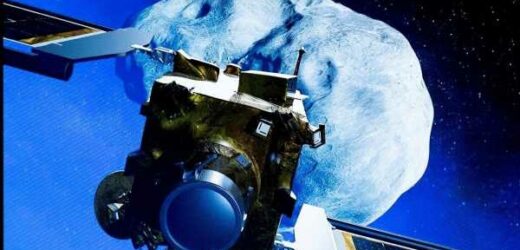NASA’s DART mission hits asteroid Dimorphos in defence test
We use your sign-up to provide content in ways you’ve consented to and to improve our understanding of you. This may include adverts from us and 3rd parties based on our understanding. You can unsubscribe at any time. More info
NASA’s mission to test whether the world could one-day be saved from a doomsday scenario in which an asteroid comes on a collision course with our planet has proved successful after it was confirmed that a giant space rock changed its destined path following impact with the DART craft. The US space agency’s DART probe was sent out into the cosmos to deliberately collide with the 60m-wide space rock called Dimorphos, which it struck head-on last month. But it was not until this Tuesday that NASA could confirm that the impact successfully budged the asteroid off-course after researchers took measurements from their observations using a variety of space and Earth-based telescopes.
While Diomorphos was only a test-run, it marks a major breakthrough for planetary defence and could help to one day save the entire world from Armaggedon if such a scenario ever occurs. NASA’s administrator Bill Nelson said: “This mission shows that NASA is trying to be ready for whatever the Universe throws at us. I believe that NASA has proven that we are serious as a defender of the planet.
“We captured the attnetion of millions of people around the world in this test. And that is because DART, as we call it, felt like a movie plot.”
NASA’s Double Asteroid Redirection Test (DART) is about the size of a car and marked the first-ever trial of a “planetary defence system”. The probe came smashing into Dimorphos 6.8m miles from Earth to see whether a simple, kinetic impact based on the transfer of momentum could change the space rock’s trajectory.
Dimorphos is 560 feet in diameter and is a so-called “minor-planet moon” which orbits around a larger asteroid called 65803 Didymos. Prior to DART smashing into Dimorphos, it would take Dimorphos 11 hours and 55 minutes to make one circuit around Didymos.


Now, after impact, it takes 11 hours and 23 minutes – a change of 32 minutes. Dr Nancy Chabot from the Johns Hopkins University Applied Physics Laboratory, which led the NASA mission, said: “This is a 4 percent change in the orbital period of Dimorphos around Didymos. DART just gave it a small nudge. But if you wanted to do this in the future, you’d want to do it years in advance.
“Warning time is really key here in order to enable this sort of asteroid deflection to be used in the future as part of a much larger planetary defence strategy.”
The $330million (£306million) mission took about seven years to develop and the DART probe was destroyed upon impact. Lori Glaze, director of the Planetary Science Division at NASA, said: “For the first time ever, humanity has changed the orbit of a planetary object.
“As new data come in each day, astronomers will be able to better assess whether, and how, a mission like DART could be used in the future to help protect Earth from a collision with an asteroid if we ever discover one headed our way.”

While it has been confirmed that the asteroid’s path has changed, the team is now trying to measure how much momentum was transferred from DART to Dimorphos. At the time of impact, the prob was storming through the cosmos at a whopping 14,000 miles per hour (22,530 kilometers per hour). Now, astronomers are set to analyse the volume of rocks and dust that were sent rocketing into space after the impact.
Dr Chabot said: “DART has given us some fascinating data about both asteroid properties and the effectiveness of a kinetic impactor as a planetary defence technology. The DART team is continuing to work on this rich dataset to fully understand this first planetary defense test of asteroid deflection.”
According to Megan Bruck Syal from Lawrence Livermore National Laboratory, the test does not signal that Earth may be completely ready for a seirous threat just yet. She told National Geographic: “In a real emergency, we might need to impart a much larger change in velocity, and the asteroid might be more massive.
“If we needed more than one kinetic impact to successfully move an asteroid off of an Earth-impacting trajectory, a dust-filled environment may be more challenging for navigating a second impactor at the target asteroid.”
DON’T MISS
US’ biggest warship embarks on Atlantic voyage in huge threat to Putin [REPORT]
Britons set for huge £1,000 boost with fracking companies offer reward [INSIGHT]
Royal Navy urged to lead France and Sweden to defend critical cables [REVEAL]


The Dimorphos and Didymos were chosen by NASA for the DART test for various different reasons, including both their relative closeness to Earth.
The space agency also chose these space rocks as they are part of a binary system, meaning it is possible to calculate any changes to Dimorphos’s velocity by tracking how often the light from Didymos dims when its satellite passes in front of it.
Neither of them pose a threat to Earth, and never did, and will continue their orbit around the sun.
The DART probe was launched by SpaceX’s Falcon 9 rocket, a reusable, two-stage rocket designed and manufactured by Elon Musk’s company for the reliable and safe transport of people and payloads into Earth orbit and beyond.
The rocket model has so far been used for 180 launches, including the mission to bring mr Musk’s Starlink satellites, also from the Vandenberg Space Force Base in California, where the DART probe first began its mission.
Source: Read Full Article


